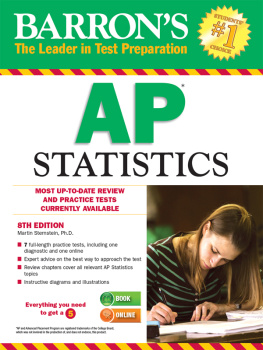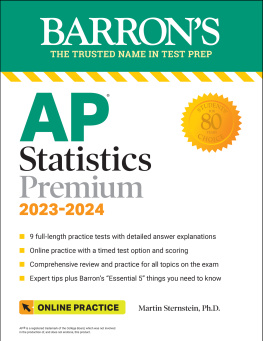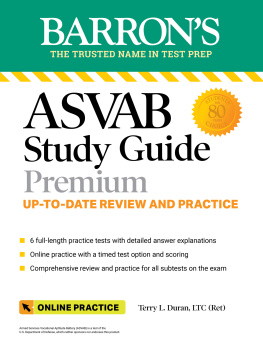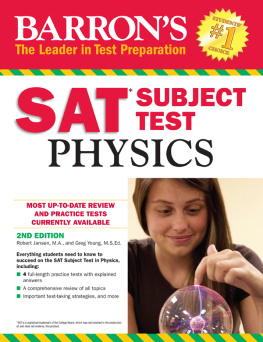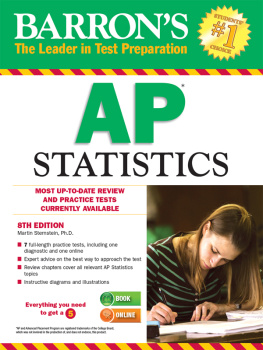
Now Available!

Go to barronsbooks.com/AP/stats/ to take a free sample AP Statistics test, complete with answer explanations and automated scoring.
*This online test was created for devices that support Adobe Flash Player. To access the test on an Apple iPad or iPhone you will need to install a web browser that supports Flash (check the iTunes App Store for free options).
Authors Note
In 1997, 7,667 students took the AP Statistics exam, and as enrollment in AP Statistics classes increased at a higher rate than in any other AP class, 184,572 students took the exam in 2014. The number of students required to take statistics in college has surpassed the number of students required to take calculus. High schools across the country have recognized this trend and are developing and expanding their statistics offerings. The new Common Core mathematics standards feature statistics and probability in a primary role throughout the high school curriculum. This Barrons book is intended both as a topical review during the year and for final review in the weeks before the AP exam. Step-by-step solutions with detailed explanations are provided for the many illustrative examples and practice problems as well as for the six practice tests, including a diagnostic test.
Special thanks are due to Steve Hanson, Dave Bock, Lee Kucera, Dawn Dentato, Brendan Murphy, Daren Starnes, and Jane Viau for their many useful suggestions. Thanks to Linda Turner, senior editor at Barrons, for her guidance. Thanks to my brother, Allan, my sons, Jonathan and Jeremy, my daughters-in-law, Cheryl and Asia, and my grandsons, Jaiden and Jordan, for their heartfelt love and support. Most thanks of all are due to my wife, Faith, whose love, warm encouragement, and always calm and optimistic perspective on life provide a home environment in which deadlines can be met and goals easily achieved.
Ithaca College
Spring 2015 | Martin Sternstein |
Copyright 2015, 2013, 2012, 2010, 2007 by Barrons Educational Series, Inc.
Copyright 2004, 2000, 1998 by Barrons Educational Series, Inc., under the title How to Prepare for the AP Advanced Placement Exam in Statistics.
All rights reserved.
No part of this publication may be reproduced or distributed in any form or by any means without the written permission of the copyright owner.
All inquiries should be addressed to:
Barrons Educational Series, Inc.
250 Wireless Boulevard
Hauppauge, New York 11788
www.barronseduc.com
eISBN: 978-1-4380-6730-8
Contents

.
.
.
.
.
.
.
.
.
.
.
.
.
.
.
As you review the content in this book and work toward earning that on your AP STATISTICS exam, here are five things that you MUST know:
Graders want to give you credithelp them! Make them understand what you are doing, why you are doing it, and how you are doing it. Dont make the reader guess at what you are doing.
Communication is just as important as statistical knowledge!
Be sure you understand exactly what you are being asked to do or find or explain.
Naked or bald answers will receive little or no credit! You must show where answers come from.
On the other hand, dont give more than one solution to the same problemyou will receive credit only for the weaker one.
Random sampling and random assignment are different ideas!
Random sampling is use of chance in selecting a sample from a population.
A simple random sample (SRS) is when every possible sample of a given size has the same chance of being selected.
A stratified random sample is when the population is divided into homogeneous units called strata, and random samples are chosen from each strata.
A cluster sample is when the population is divided into heterogeneous units called clusters, and a random sample of the clusters is chosen.
Random assignment in experiments is when subjects are randomly assigned to treatments.
This randomization evens out effects over which we have no control.
Randomized block design refers to when the randomization occurs only within groups of similar experimental units called blocks.
Distributions describe variability! Understand the difference between:
a population distribution (variability in an entire population),
a sample distribution (variability in a particular sample), and
a sampling distribution (variability between samples).
The larger the sample size, the more the sample distribution looks like the population distribution.
Central Limit Theorem: the larger the sample size, the more the sampling distribution (probability distribution of the sample means) looks like a normal distribution.
Check assumptions!
Be sure the assumptions to be checked are stated correctly, but dont just state them!
Verifying assumptions and conditions means more than simply listing them with little check marksyou must show work or give some reason to confirm verification.
If you refer to a graph, whether it is a histogram, boxplot, stemplot, scatterplot, residuals plot, normal probability plot, or some other kind of graph, you should roughly draw it. It is not enough to simply say, I did a normal probability plot of the residuals on my calculator and it looked linear.
Calculating the P -value is not the final step of a hypothesis test!
There must be a decision to reject or fail to reject the null hypothesis.
You must indicate how you interpret the P -value, that is, you need linkage. So, Given that P = 0.007, I reject isnt enough. You need something like, Because P = 0.007 is less than 0.05, there is sufficient evidence to reject
Finally, you need a conclusion in context of the problem.
This e-Book will look differently depending on what device you are using to view it on. Illustrations, line numbers, equations, etc. will adjust according to your settings.
There are hundreds of hyperlinks in this e-Book that will help you navigate through content, bring you to helpful resources, and allow you to click between all questions and answers in both practice exercises and model exams.

T he contents of this book cover the topics recommended by the AP Statistics Development Committee. A review of each of the 15 topics is followed by multiple-choice and free-response questions on that topic. Detailed explanations are provided for all answers. It should be noted that some of the topic questions are not typical AP exam questions but rather are intended to help review the topic. Finally, there is a diagnostic exam, and there are five full-length practice exams, totaling 276 questions, all with instructive, complete answers. An optional disk contains two new, full-length exams with 92 more questions.
Several points with regard to particular answers should be noted. First, step-by-step calculations using the given tables sometimes give minor differences from calculator answers due to round-off error. Second, calculator packages easily handle degrees of freedom that are not whole numbers, also resulting in minor answer differences. In the above cases, multiple-choice answers in this book have only one reasonable correct answer, and written explanations are necessary when answering free-response questions.
Next page
